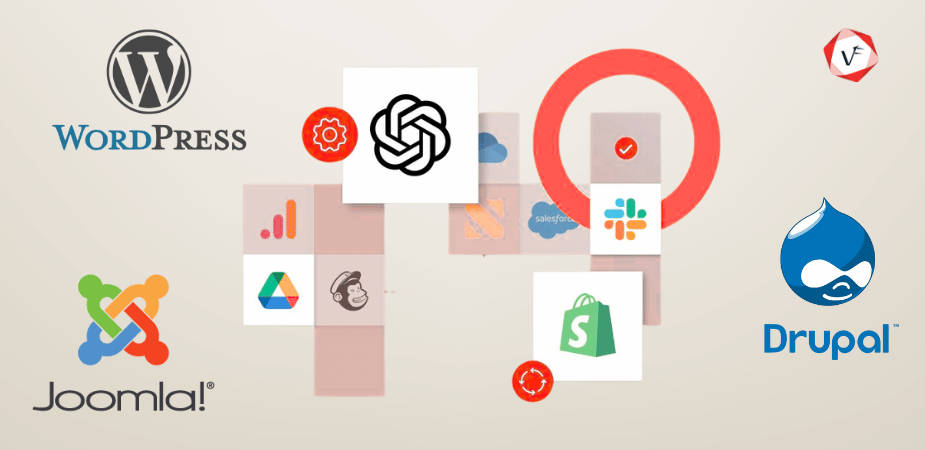- February 24, 2025 10:54 pm
- by Kevin
- February 24, 2025 10:54 pm
- by Manek

A Content Management System(CMS) is the backbone of a website, providing a framework for creating, managing, and modifying digital content. Whether you're using WordPress, Drupal, Joomla, or any other CMS platform, integrating third-party tools can significantly enhance the functionality of your site. These tools can help with everything from improving SEO and managing customer relationships to automating marketing tasks and securing your website. This article will guide you through the process of integrating third-party tools with your CMS, focusing on the benefits, best practices, and tools you should consider.
A CMS alone can handle many tasks, but integrating third-party tools can take your website's performance and functionality to the next level. Here are some reasons why integrating third-party tools with your CMS is crucial:
Enhanced Functionality: While CMS platforms are versatile, they may not cover all your specific needs. Third-party tools provide specialized features that are often more powerful or customizable than native CMS options.
Improved User Experience: Third-party integrations can offer better performance, responsiveness, and user engagement, leading to higher satisfaction and retention rates.
Cost and Time Efficiency: Instead of developing new features from scratch, integrating existing tools can save both time and resources.
Scalability: Third-party tools often come with built-in scalability options, making it easier to handle growing traffic and data without the need for extensive redesign or redevelopment.
By integrating these tools, you can customize your CMS to better suit your business requirements and deliver a more comprehensive and seamless experience to your users.
To understand how to integrate third-party tools with your CMS effectively, it's essential to know the different types of tools available. Here are some of the most popular categories:
SEO Tools: Tools like Yoast SEO, SEMrush, and Moz help optimize content for search engines. They provide functionalities such as keyword analysis, content suggestions, backlink tracking, and performance monitoring.
Analytics Tools: Google Analytics, Hotjar, and Crazy Egg provide deep insights into user behavior, website traffic, and conversion rates, enabling data-driven decisions.
CRM Tools: Customer Relationship Management (CRM) tools like HubSpot, Salesforce, and Zoho integrate with your CMS to manage customer data, track interactions, and streamline sales processes.
E-Mail Marketing Tools: Tools like Mailchimp, Constant Contact, and Sendinblue allow for seamless email campaign management, from building mailing lists to creating and automating email content.
eCommerce Tools: For websites that sell products, integrating e-commerce platforms like WooCommerce, Shopify, or Magento can help manage sales, inventory, and customer orders directly from the CMS.
Security Tools: Security plugins and tools such as Wordfence, Sucuri, and Cloudflare provide protection against malware, hacking attempts, and data breaches.
Social Media Tools: Tools like Buffer, Hootsuite, and SocialBee facilitate social media integration, enabling content sharing across platforms and providing analytics for social media performance.
Before integrating third-party tools with your CMS, there are several factors to consider to ensure a smooth process:
Compatibility: Verify that the tool is compatible with your CMS version. Most tools specify which CMS platforms and versions they support.
Performance Impact: Some integrations may affect your website's performance, slowing down load times or increasing server strain. Make sure to check the tool's requirements and optimize your site accordingly.
Security: Always ensure that the third-party tools you choose are secure and trusted by the community. Look for plugins or tools with good reviews, regular updates, and support from the developers.
Scalability: Choose tools that can scale with your business needs. You should consider whether the tool can handle an increase in traffic, data, and users.
Cost: Many third-party tools come with subscription fees or one-time costs. Analyze your budget and consider the long-term costs and benefits.
Once you have considered these factors, you can move forward with integrating the tools into your CMS.
Here is a step-by-step guide to help you integrate third-party tools with your CMS effectively:
To ensure a successful integration, follow these best practices:
Use Reputable Tools: Choose third-party tools with a solid reputation, high user ratings, and consistent updates. Avoid tools that have a history of security vulnerabilities or poor support.
Backup Your Website: Before making any changes or integrations, always create a backup of your website. This step ensures that you can restore your site to its original state if anything goes wrong.
Limit the Number of Tools: Avoid overloading your CMS with too many third-party tools. Each tool you add can impact performance and security. Only use tools that are essential for your website's functionality.
Regular Updates: Keep all third-party tools updated to the latest versions to protect against security vulnerabilities and ensure compatibility with your CMS.
Monitor Performance: Regularly monitor your website's performance, especially after integrating new tools. Use analytics to track site speed, user engagement, and other key metrics.
Read the Documentation: Always read the tool's documentation to understand its features, settings, and potential limitations. Proper knowledge will help you make the most out of the integration.
While integrating third-party tools with your CMS offers many benefits, there can be challenges, such as:
Compatibility Issues: Some tools may not work well together or with specific CMS versions. To avoid this, always check for compatibility information and test tools in a staging environment.
Performance Overhead: Adding too many tools can slow down your website. Focus on integrating only those tools that provide the most value and regularly monitor performance.
Security Risks: Third-party tools can introduce vulnerabilities. Use tools from trusted developers, keep them updated, and monitor for security alerts.
Costs: Some premium tools can be expensive. Evaluate your budget and consider the ROI before committing to any tool.
Integrating third-party tools with your CMS is a strategic move to enhance your website's functionality, improve user experience, and streamline business processes. By carefully selecting and configuring these tools, you can leverage their capabilities to meet your specific needs. Remember to follow best practices, monitor performance, and regularly update all tools to ensure a secure and efficient integration. By leveraging the right third-party tools and CMS development services, you can create a website that is both powerful and adaptable, ready to meet the challenges of today's digital landscape. If you're looking for a comprehensive solution to build, customize, or optimize your CMS, Vofox's CMS development services provide expert guidance and tailored solutions to meet your needs. Explore more by contacting us today.
Guaranteed Response within One Business Day!

What is Digital Twin Technology?

What are WebAssembly (WASM) Applications?
Code Review Best Practices: Complete Guide for 2026

Database Selection Guide: SQL vs NoSQL
AI Agents in Enterprise Software: How Autonomous AI is Transforming Business Operations